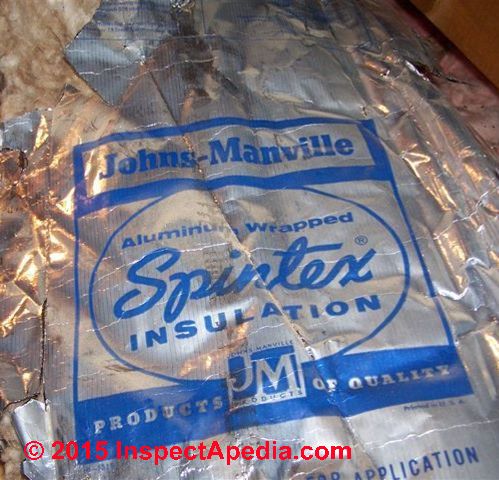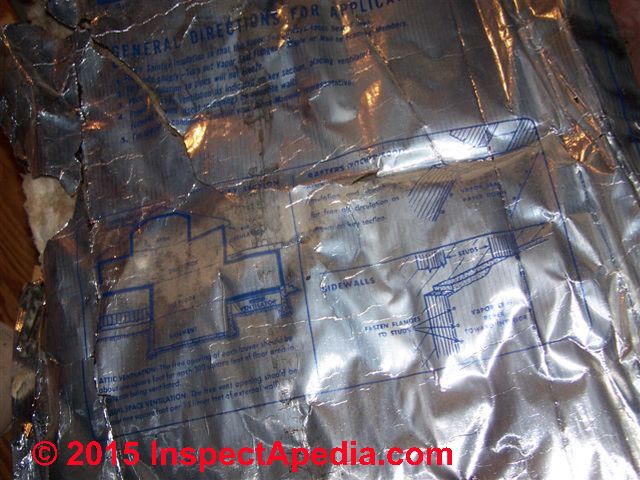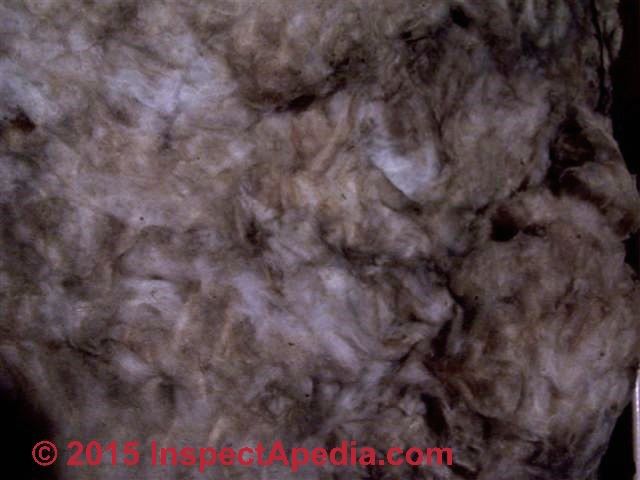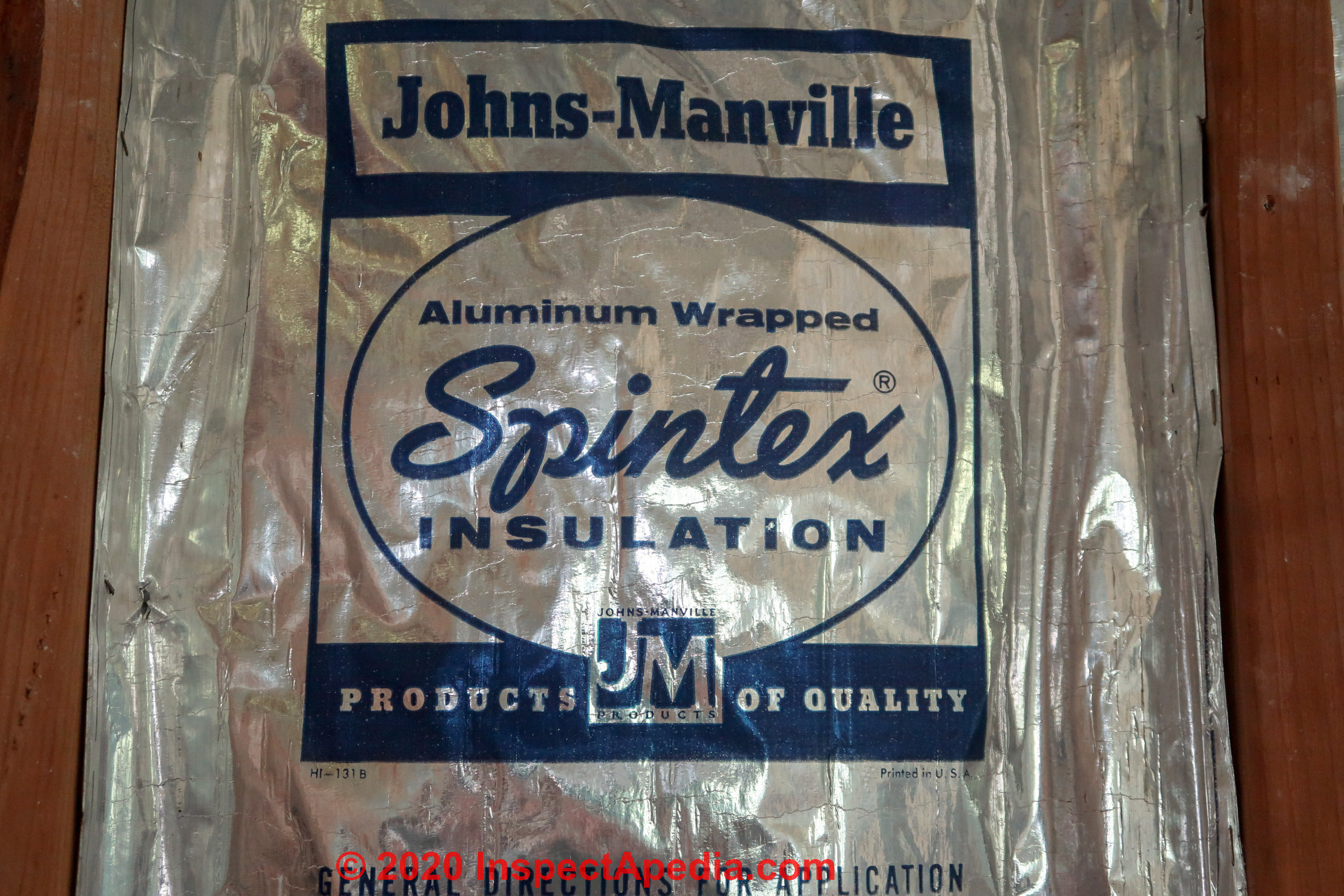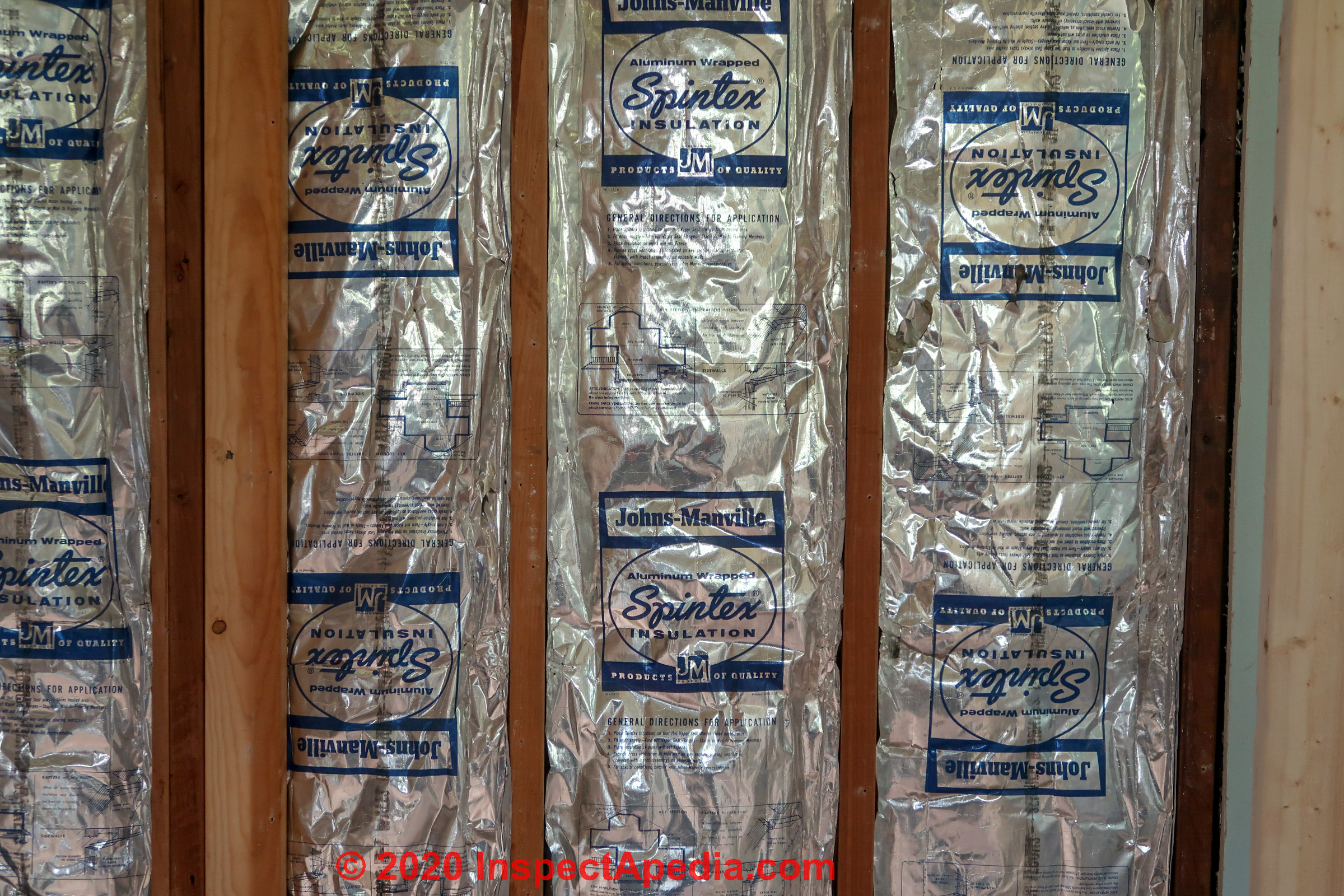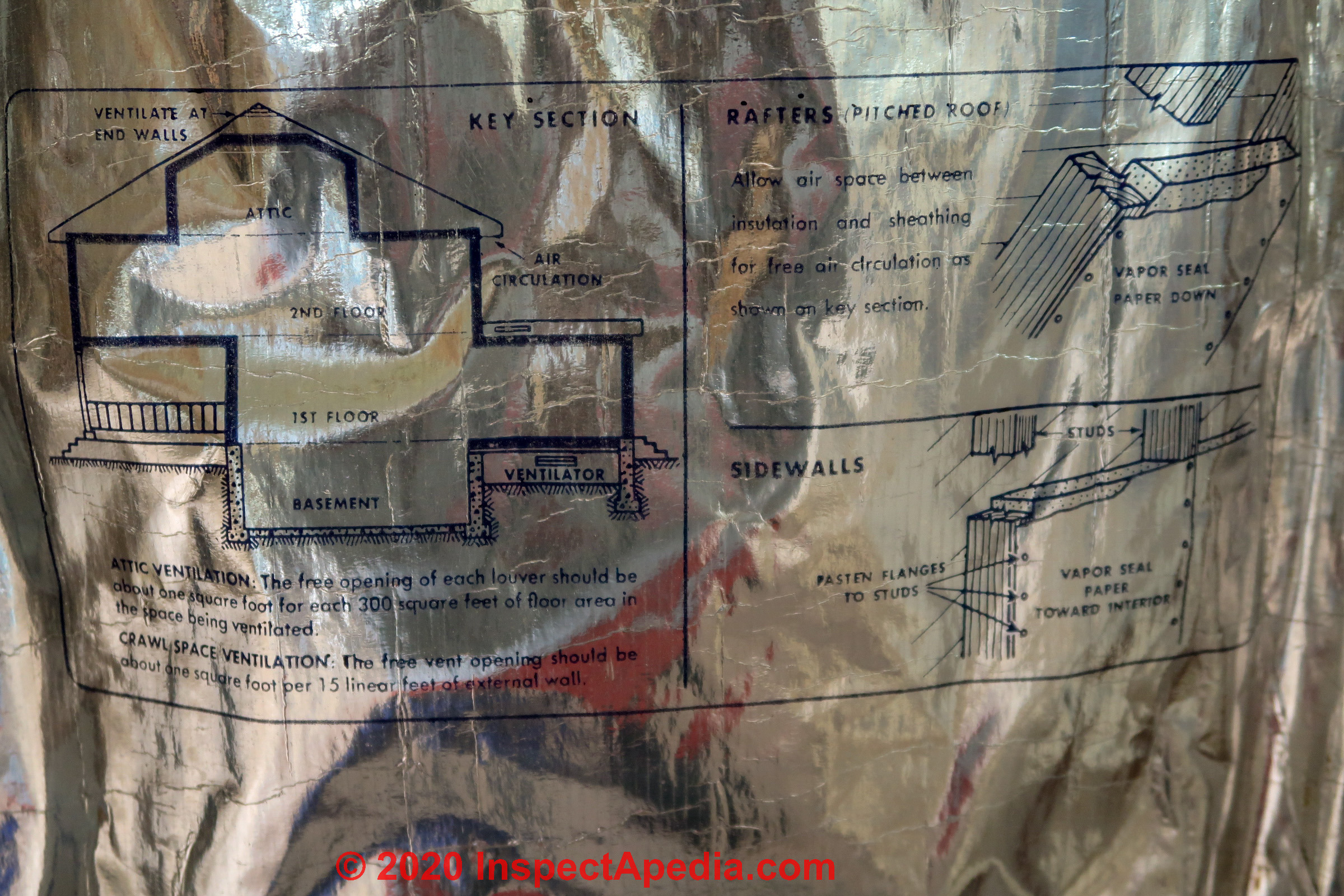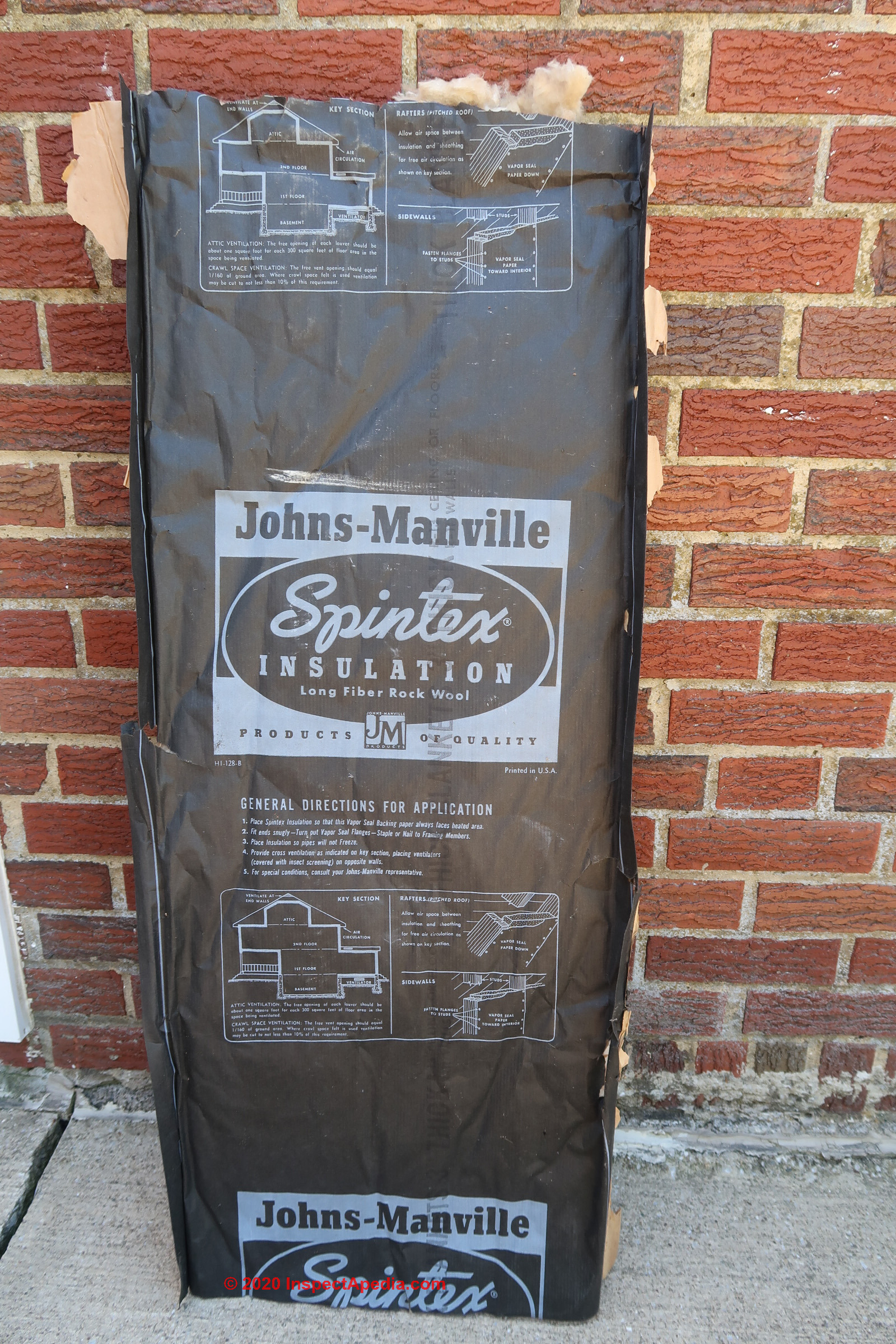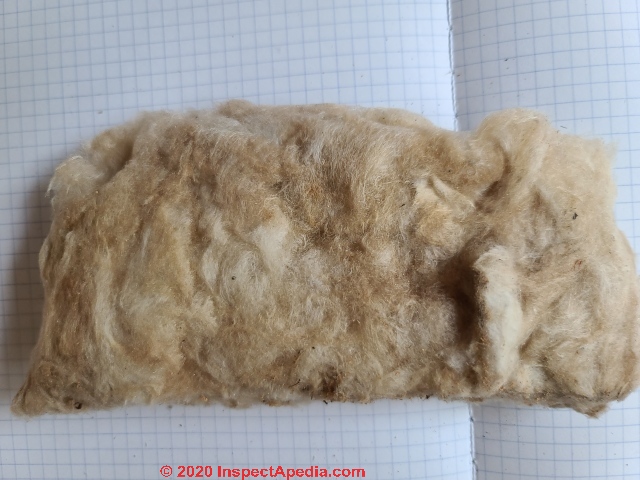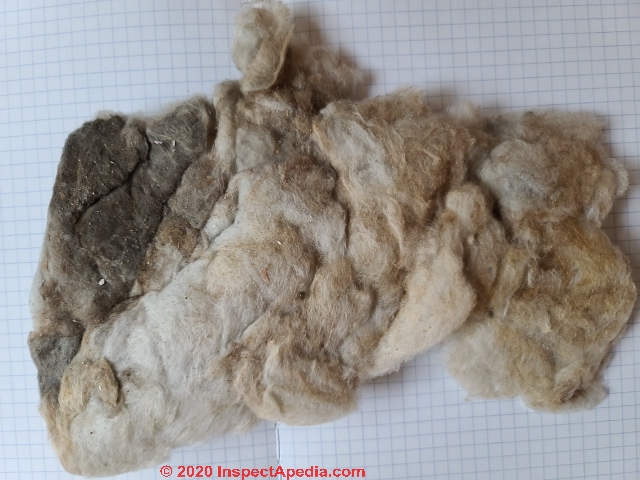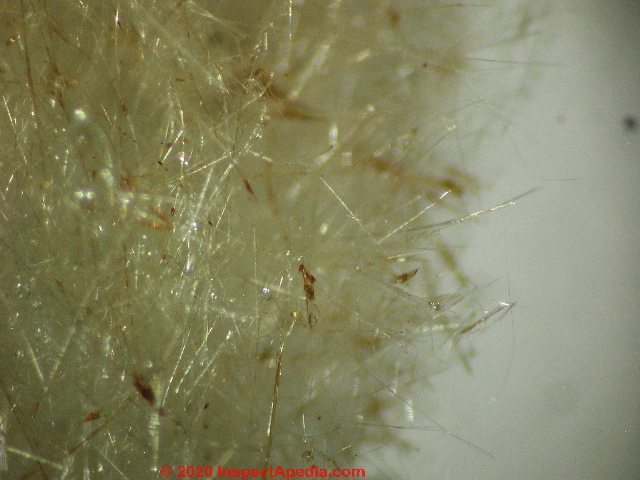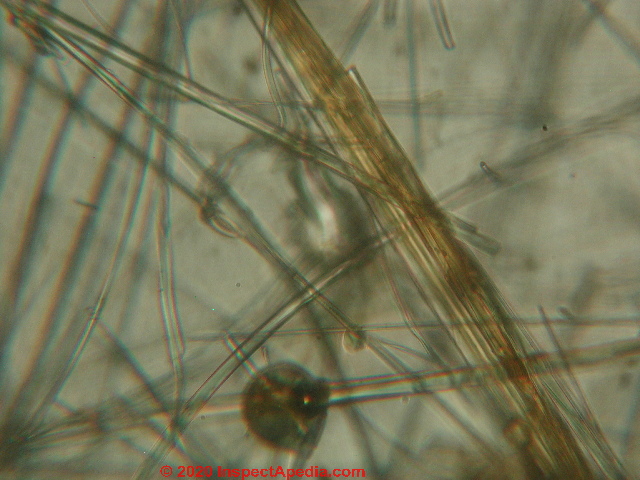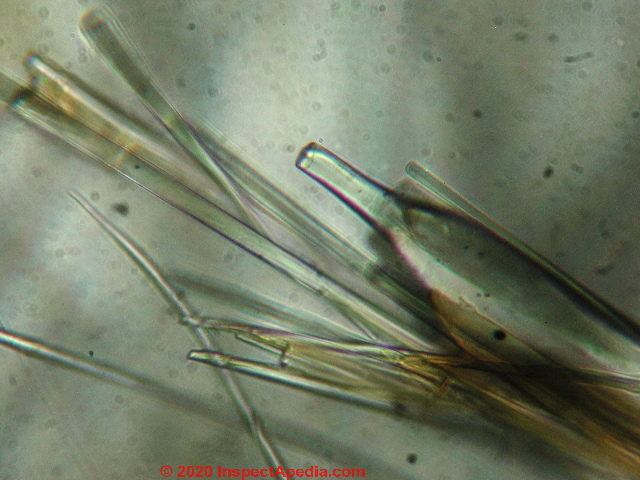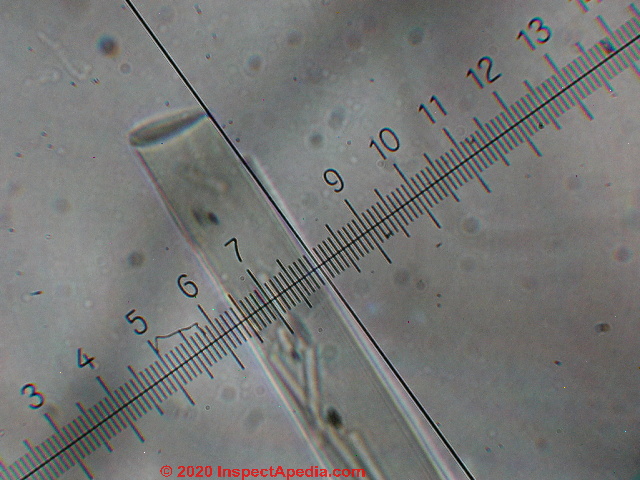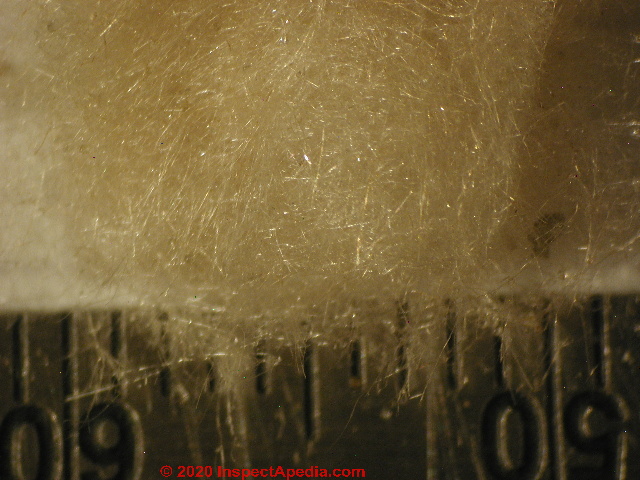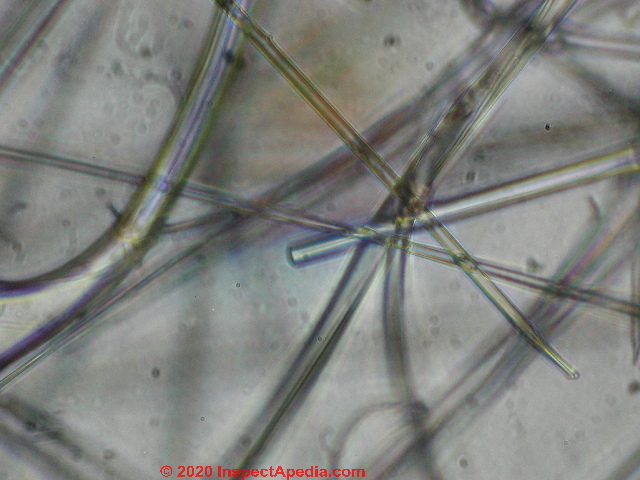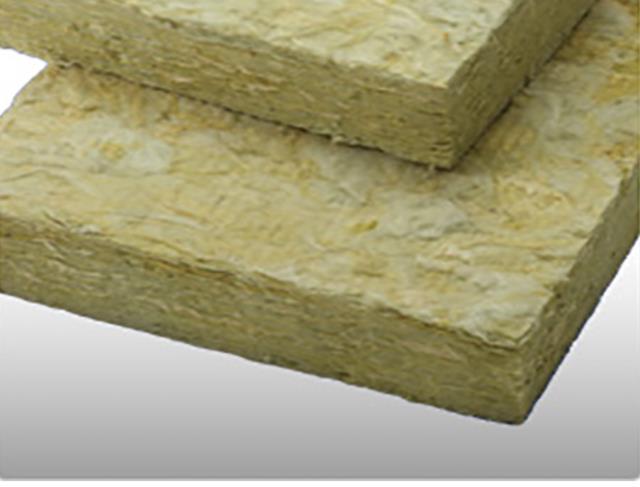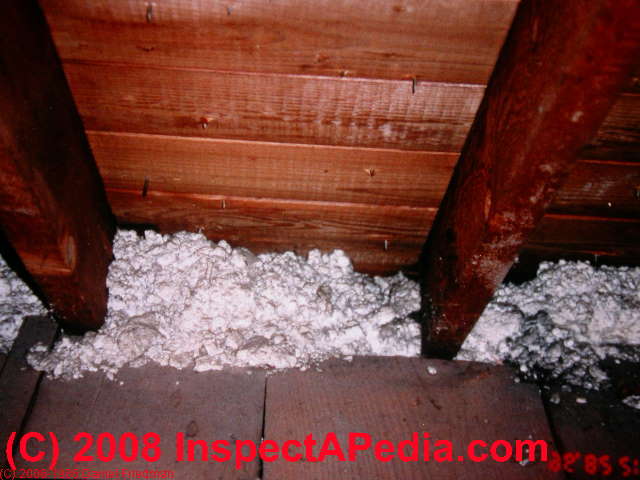 Asbestos Content in Mineral Wool or "rock wool" ?
Asbestos Content in Mineral Wool or "rock wool" ?
Johns Manville Spintex & asbestos in mineral wool,
stone wool, rock wool, slag wool?
- POST a QUESTION or COMMENT about asbestos content in mineral fiber insulation & properties of Johns Manville Spintex® insulation.
Rock wool or mineral wool insulation:
Was there asbestos found in mineral wool, slag wool also commonly referred to as rock wool used for building insulation?
Properties of Johns-Manville Spintex® and other mineral wool products.
This mineral wool or "rock wool" insulation article discusses the asbestos content in mineral wool insulation products.
The short answer is "no asbestos" but we found that there are exceptions and some specialty mineral wool products indeed asbestos in paper with mineral wool or asbestos with mineral wool to form insulating cement products. We describe those on this page.
This article series assists anyone who needs to identify various insulation materials in buildings by simple visual inspection. We provide photographs and descriptive text of various types of mineral wool insulation and describe its properties, how it is made, health and maintenance concerns, and its insulating values.
InspectAPedia tolerates no conflicts of interest. We have no relationship with advertisers, products, or services discussed at this website.
- Daniel Friedman, Publisher/Editor/Author - See WHO ARE WE?
Mineral wool or "rock wool" or "slag wool" Building Insulation
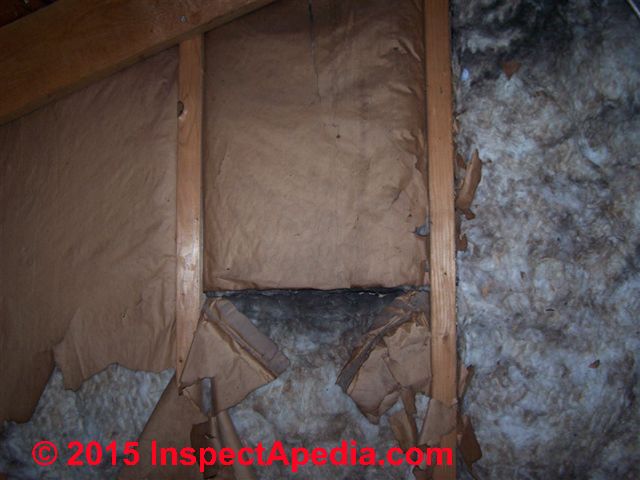 Mineral wool insulation, developed in the 1850's, patented in 1875 in the U.S. and this material, also called rock wool or in some texts slag wool insulation remained in popular use in the U.S. up to the 1950's, and is still in use today (2008) in some new construction, in manufactured housing, and in special applications such as the insulation of low-slope roofed cathedral ceilings and scissors-truss roofs.
Mineral wool insulation, developed in the 1850's, patented in 1875 in the U.S. and this material, also called rock wool or in some texts slag wool insulation remained in popular use in the U.S. up to the 1950's, and is still in use today (2008) in some new construction, in manufactured housing, and in special applications such as the insulation of low-slope roofed cathedral ceilings and scissors-truss roofs.
Article Contents
- DOES ROCK WOOL SLAG WOOL MINERAL WOOL INSULATION CONTAIN ASBESTOS? - generally no
- ASBESTOS COMBINED with MINERAL WOOL in SOME PRODUCTS - not insulating batts
- Johns Manville SPINTEX® INSULATING BATTS
- Johns Manville SPINTEX MINERAL WOOL FORENSIC LAB PHOTOS
- RESEARCH on ASBESTOS COMBINED with MINERAL / ROCK WOOL
Do Rock Wool, Slag Wool, or Mineral Wool Insulation contain asbestos fibers?
Mineral wool insulation, slag wool insulation, and "rock wool" building insulation either in batt form or as loose fill would, in almost all cases, not be expected to contain asbestos fibers.
There were a few exceptions but those are not likely to be found as ordinary building insulation.
There were some mineral wool products that deliberately combined asbestos, such as layers of asbestos paper, with mineral wool, and other inventors experimented with combining other fibers such as flax with mineral wool to reduce its tendency to settle in vertical installations such as wall cavities.
Below you'll find our references to asbestos combined with mineral wool building insulation by an the Alabama Rock Wool Manufacturing company.
Do Old Rock Wool Blankets Residential Home - contain asbestos?
Do old Rock Wool blankets (kraft or foil faced insulating batts) contain asbestos? As described by an InspectApedia.com reader:
These insulating blankets are quite heavy, filled with what looks like reddish brown dirt and tiny pebbles and tiny pieces of fiber, paper covered with a blue or black manufacturer's label box framed picture of a house on the right and instructions on the left that states Rock Wool above it.
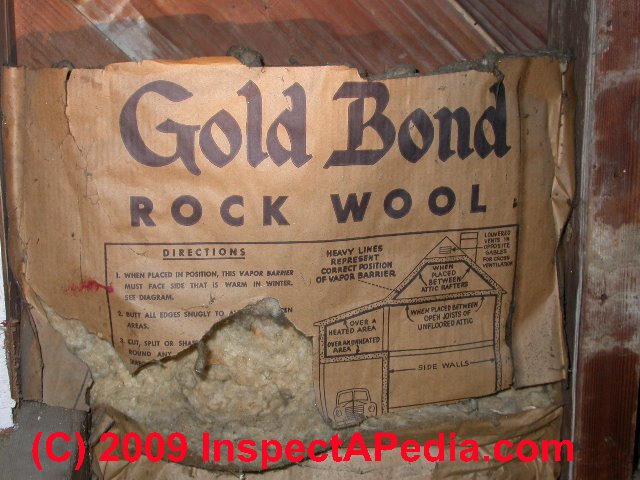 I'm not sure of the date it was installed. My father and uncle could have installed it in or after 1975 when my mom and dad and my uncle's family purchased the place, or it was installed by the original owner.
I'm not sure of the date it was installed. My father and uncle could have installed it in or after 1975 when my mom and dad and my uncle's family purchased the place, or it was installed by the original owner.
I'll have to check the deed to see when the house was built. My sisters and I inherited the summer home which is in Espyville, PA.
About four years ago I got permission from my family to begin remodeling.
I was so excited to do the job that I began pulling the paperboard ceiling and walls on the second floor without thinking and out plopped one of these blankets that broke open spewing dust into the air. I stopped immediately.
After returning home, I tried to find this insulation on the Internet. I did find an old homes and historic homes site that had an exact picture of it and the manufacturer's label that looked identical and it stated that this type old insulation does not contain asbestos.
I found another site that stated some old Rock Wool insulation did contain asbestos, but this type was only used in high heat applications on hydronic piping, and not likely in residential attic/wall applications.
I convinced myself that I would be ok for I was anxious to remodel and my brother in law and I continued the job wearing only paper masks. It sure was a dirty job.
The second floor only has two bedrooms, but I was surrounded in dust.
I did open the florida windows and placed a fan inside for ventilation, waited for some dust to dissipate out of the windows, took frequent breaks to fresh cool outside air when the heat and dust got to be too much. also doubled up on the paper mask when I noticed dust was getting below a single mask and frequently changed masks.
But I don't know what good those paper masks did for me if at all. It took us two (6 hr days) and one (4 hr day) to complete removing the wall and ceiling boards and insulation (only one bedroom had this insulation).
Then my sister and I went there the following weekend to wash things down and place fiberglass insulation (6 hr job). All and all I would say I exposed myself to about 12 min. to 18 max. hours to Rock Wool dust using only paper masks.
Now I'm worried sick from seeing Mesothelioma commercials making me check more sites on the net and found sites that state some old Rock Wool blankets can contain asbestos.
What to do? Please help with any knowledge of old Rock Wool. Meantime I'm going to see if I can find some of it on the first floor and have it tested. I don't have any health symptoms, but I am going to make an appointment with my doctor anyway and get a ct scan for peace of mind. Thank you very much for your help, J.C. - (July 25, 2011) JC said:
And from another InspectApedia reader:
I found Gold Bond rock wool name on it. I think the manufactor is or was in Buffalo New York. Does it contain abestos just like the pitcure above?
Its the same as the picture above - (Dec 5, 2012) Mike
Reply: Normally mineral wool or "rock wool" slag wool or stone wool insulation does not contain asbestos but there are exceptions
It would be unusual for a residential home to have rock wool insulation containing asbestos - to know with absolute certainty I'd have a sample of the insulation tested.
Shown here: photographs of Gold Bond™ brand mineral wool insulation in a 1960's Haddonfield New Jersey Home.
A more immediate concern is doing any construction demolition involving lots of dust and debris without wearing adequate HEPA-rated filtered respirators.
Acute exposure or chronic exposure to many if not most dusts can lead to lung and eye irritation and adult onset asthma. And of course if the building dust was contaminated with bird droppings, rodent droppings, or similar, there may be bacterial or viral hazards too.
If you are having respiratory distress you'll want to go to your primary care physician, discuss your concern and case history, and most likely the doctor will refer you to a pulmonologist for some simple lung tests, or to a doctor specializing in environmental medicine.
Bottom line: According to a 1980 US EPA study the principal airborne hazards associated with mineral wool products were in its manufacture.
Also see MINERAL or SLAG WOOL HEALTH EFFECTS
- U.S. EPA, SOURCE CATEGORY SURVEY: MINERAL WOOL MANUFACTURING INDUSTRY [PDF] U.S. Environmental Protection Agency, Office of Air, Noise, and Radiation, Office of Air Quality Planning and Standards, Research Triangle Park, North Carolina 27711 (March 1980)
Examples of Asbestos Use in Mineral Wool Products
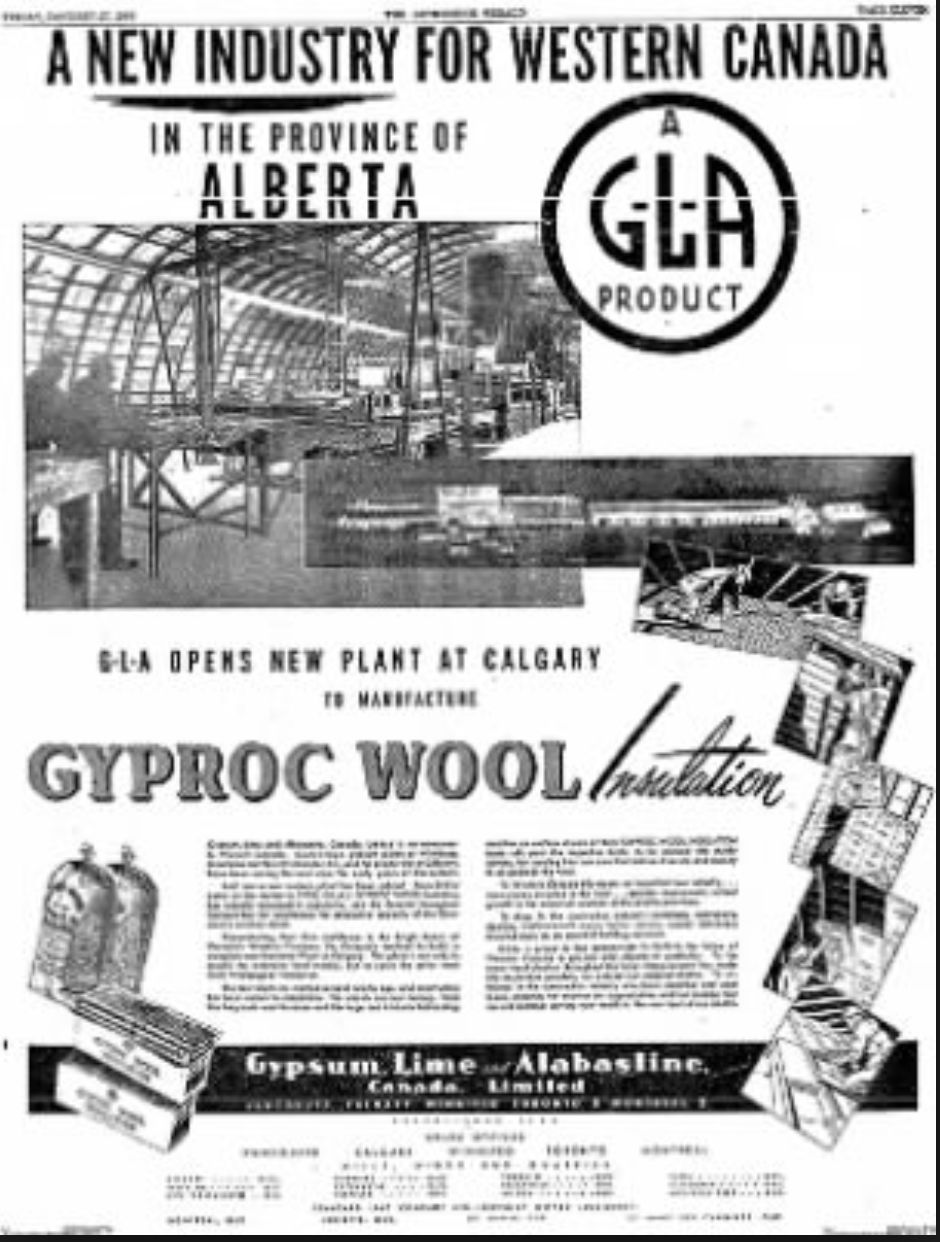 A look at mineral wool patents between 1900 and 1930 finds hundreds of patent citations: there was a lot of activity for blowing mineral wool from slag, for making mineral wool felt, for numerous heat-insulating applications. Below are a couple of examples. Other research its cited throughout this article series.
A look at mineral wool patents between 1900 and 1930 finds hundreds of patent citations: there was a lot of activity for blowing mineral wool from slag, for making mineral wool felt, for numerous heat-insulating applications. Below are a couple of examples. Other research its cited throughout this article series.
Of interest was research on combining mineral wool with other fibers such as flax (which didn't settle) in an effort to reduce settling in walls (Kelly Sept 1901). So indeed we might find some hybrid mineral wool or slag wool products.
And while mineral wool is not an asbestos material, some applications experimented with stitching asbestos and mineral wool together. (Kelly Feb 1901).
Not to worry, from reading the patent description the asbestos combined with mineral wool by Kelly (cited below) would have been recognizable as layers of thin sheets of stitched-on paper.
- Emrick, Frank C. "Insulating material and method of manufacturing the same." U.S. Patent 1,426,163, issued August 15, 1922.
- Gyproc Wool Insulation, produced by GYPSUM, LIME & ALABASTINE CANADA, LIMITED,
50 Maitland St., Toronto, Ontario, Canada, with facilities in Vancouver, Calgary, Winnipeg, Toronto, Montreal Canada, [illustration shown here] was advertised in
The Lethbridge Herald from Lethbridge, 27 January 1950, p. 11.
There is no mention of asbestos in this product. - Hall, Charles C. "Process of making mineral-wool felt." U.S. Patent 737,099, issued August 25, 1903.
- Kelly, George. "Insulating and fireproof sheeting." U.S. Patent 668,684, issued February 26, 1901.
- Kelly, George. "Composite insulating material." U.S. Patent 683,208, issued September 24, 1901.
Excerpt:
The object of my invention is to produce a sheet of the character specified of natural fireproof materials-as, for instance, asbestos paper and mineral-wool fiber united in layers by means of stitching of novel form designed to retain the layers without pulling through the soft material, the uniting stitching or lines ofstitches being disposed and arranged in a manner to facilitate the folding or rolling of the sheets into small compass for storage or transportation.
Asbestos Used bt the Alabama Rock Wool Company
Insulating cement products using asbestos led to litigation and bankruptcy.
The original Rock Wool Company, (located in Leeds Alabama, founded in 1943) produced rock wool used for blown-in building insulation and other insulating products.
From about 1958 to 1970, as a new product line, the company added asbestos to rock wool to form insulating cement boards and other insulating cement-based products such as an insulating lagging or paste applied to heating pipes and possibly some heating boilers.
The principal exposure hazard was to workers of Rock Wool Co. where these products were manufactured.
- AF Cement
- Delta Maid High Temp Insulating Cement
- Delta Maid High Temp Mater-Cement
- Delt Maid One-Shot Insulating Cement
In 1994 Rock Wool was found guilty of producing "unreasonably dangerous products" and was required to pay damages. The company faced about 150,000 asbestsos-related lawsuits.
In 1996 the Alabama Rock Wool Company filed for Chapter 11 bankruptcy as a result of that asbestos-related litigation. In December 1999 the company emerged from bankruptcy to form the Rock Wool Asbestos Trust to settle various litigation-related claims.
The period for filing claims against the Rock Wool Company trust ended on 13 January 2011.
Properties & Contents of Johns Manville Spintex® Insulating Batts
Reader Question: Is there Asbestos in Johns Manville Spintex Batt Insulation? History & Properties of Johns Manville Spintex® Insulation
Does John Manville Aluminum Wrapped Spintex batt Insulation (with aluminum foil on one side and [brown kraft] paper on the other side) contain asbestos and what would be the R value.
The insulation is from the 1950's. There's a number on the aluminum side Hl-131B - Dan. 05/03/2015
This question was originally posted
at INSULATION INSPECTION & IMPROVEMENT
Reply: Most mineral wool insulation does not contain asbestos but there is at least one known exception from an Alabama manufacturer
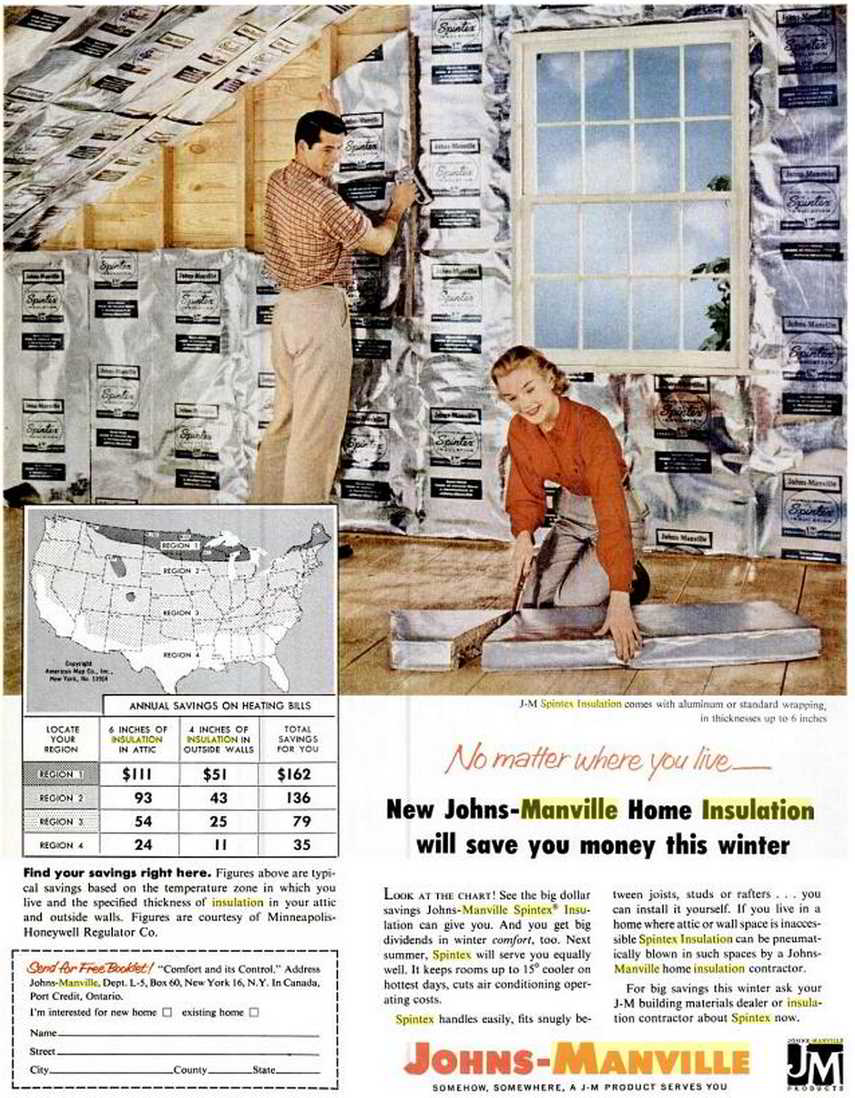
The short answer is that all research we've made to date indicates that Johns Manville Spintex® batt insulation was a rock wool or "mineral wool" foil faced insulating batt product.
Spintex™ foil faced insulating batts produced by Manville were sold in thicknesses up to 6 inches.
Rock wool (or slag wool or mineral wool insulation) is not an asbestos material.
Watch out: however historical research cited below claims that asbestos was added to rock wool by at least one manufacturer, Rock Wool Manufacturing Company, in Leeds, Alabama.
Asbestos was added to the company's "rock wool" insulation for insulating value or as a binder according to sources cited below.
Also if mineral wool or rock wool was produced at a facility that also handled asbestos there is a possibility of some cross-contamination between the materials. So without a lab test one cannot absolutely guarantee that mineral wool or "rock wool" is asbestos free.
[Click to enlarge any image]
Spintex® was described as well as a "blown home insulation" in the form of Spintex batts and blankets. - Johns-Manville Corp.,
"Asbestos the Magic Mineral", [8 MB PDF] Johns Manville on the occasion of its 100th Anniversary, when in 1958 the company described its use of mineral slag (obtained as a byproduct from metal refining) beginning as early as 1928 and producing mineral wool. Quoting from that document,
The mineral wool is formed into small nodules and blown into the walls of older, uninsulated houses by special blowing machines. J-M mineral fibre products for home insulation include Spintex® Blown Home Insulation and Spintex batts and blankets.
These fibres are also used to produce insulations widely used in industry by manufacturers of home freezers, refrigerators, kitchen ranges, air-conditioning ducts, and many types of industrial products.
Johns-Manville plants manufacturing mineral wool products are located at Alexandria, Ind., Manville, N.J., Richmond, Inc., Watson, Calif., Waukegan, Ill, and Toronto Ontario. - [est. 1958] - retrieved 3 May 2015 original source http://www.scribd.com/doc/36151062/Johns-Manville-Document#scribd
The R-Value for Manville Spintex was about 4.8 per inch before allowing for the effects of insulation gaps or material inconsistencies.
See the illustration of this product from an October 1958 Life Magazine advertisement shown at above left.
Watch out: while Spintex® is a mineral wool or "rock wool" non-asbestos product, if it was produced at a location where asbestos products were also manufactured one cannot presume that there cannot possibly be any asbestos particles found in the material. However the lab test reports that we have reviewed have not confirmed asbestos in any rock wool or mineral wool samples.
Following are some research citations that explain the derivation of the "Spintex" term and how it was used to produce fibers and insulating products. I think the origin of spintex was a German invention (see Bechler (1947) and Eugen (1959) and earlier US Patents citing Rollenlager-Spindelfabrik Spintex GmbH, Stuttgart-Bad Cannstatt, Germany Application July 8, 1954 or earlier)
The term "spintex" described a process used to produce a spun fiber. See these citations describing Spintex Insulation and the spintex process as well as its applications. Adding to confusion about the term, Spintex Inc. continues as a Illinois corporate name in the U.S. as well as in Canada and in India.
Currently In the U.S. Spintex is an injection molding company with offices in the U.S. and Japan. In Canada Spintex is currently a furniture manufacturer in Alberta. In Bangaladesh Spintex is a textile manufacturer. And there are of course more users of the Spintex name.
Additional Photographs of Spintex® Insulation from Johns Manville, courtesy of reader DK.
Spintex H1-131B aluminum foil wrapped mineral wool insulation
Below: Johns-Manville Spintex Insulation, Long Fiber Rock Wool, H1-128-B
also provided by reader Dan, sampled from a home in N. Royalton, OH, USA.
Notice that JM's product facing identifies it as "long fiber Rock Wool" insulation.
Bulk sample images of these Spintex insulation samples will be followed by micro-photographs of these insulation products examined by transmitted and polarized light under the microscope.
Above: Johns-Manville Rock-Wool Insulation, black kraft-faced H1-128-B insulation, bulk sample.
Below: Johns Manville Rock Wool Insulation, silver or aluminum-foil faced H1-131-B insulation, bulk sample.
Also see MINERAL WOOL by MICROSCOPE
Forensic Lab Microscope Photos of Johns Manville Spintex Foil Faced Mineral Wool Insulation No. H1-131-B
These lab photos are arranged in order of increased magnification from about 10x under the stereo microscope up to 1200x under transmitted light microscopy using triacetin with phenol as a mounting fluid.
Using PLM microscopy we did not detect asbestos in these two samples of Spintex mineral wool.
and
and with a scale giving the diameter of one fiber
Below: lab photographs of Johns Manville Spintex black kraft-paper faced mineral wool insulation No. H1-128-B
[Click to enlarge any image]
and
Research on Mineral Wool, Rock Wool, Slag Wool & Asbestos in Mineral Wool Insulation
- "Asbestos in Alabama", Mesothelioma Center ( a website supporting litigation and health claims concerning asbestos exposure), Website: http://www.asbestos.com, retrieves: 2015/12/06, original source: http://www.asbestos.com/states/alabama/, Excerpts:
... Alabama has no history of mining asbestos, use of the fibrous mineral spanned multiple industries before it was recognized as a human carcinogen in the 1980s. ...
In 2004, the Birmingham News printed a series of reports on the severity of asbestos problems in Alabama.
One story detailed how Rock Wool Manufacturing, a cement manufacturer in Leeds, added asbestos to its products as a bonding agent.
When unprotected workers handled the cement, they were exposed to the toxic substance. ... A July, 2010 report in the Huntsville Times showed that workers also found asbestos during a renovation of the Von Braun Center. ... in four sections of the building.
Crews reported finding asbestos in the ductwork, in the floor tiles and in some exterior panels.
Really? Where in that report of finding asbestos "in the floor tiles and in some exterior panels" does mineral wool or rock wool appear? And where and when did the Rock Wool manufacturing company ever produce floor tiles? - Ed.
- Alabama: Birmingham News, "The Business of Death - Rock Wool, a Bad Decision", retrieved 2015/12/06, original source: http://www.al.com/birminghamnews/asbestos/ [Note: The Birmingham News does not provide the actual article text online - Ed.] Quoting:
The business of death: Rock Wool Manufacturing's decision to add asbestos to cement cost the company 140,000 lawsuits.
More recently RockWool products from the currently-existing (2024) Canadian RockWool Company are described just below. Note that documentation that we found for the Canadian Rockwool Company's products described below do not include the word "asbestos".

- RockWool Manufacturing Co., 8024 Esquesing Line,
Milton, Ontario Canada L9T 6W Web: https://www.rockwool.com/ - The company currently produces a wide range of building insulation products.
Customer service and delivery inquiries: 1-855-876-3755 (Direct) 1 (800) 265-6878 Email: cs@rockwool.com Technical product inquiries: 1-877-823-9790 (Direct)
ROCKWOOL SAFE USE INSTRUCTION SHEET [PDF] (2022)
Example products: Delta Marine Board, a semi-rigid mineral wool insulation used in marine applications, illustrated above as found for sale at https://www.generalinsulation.com/products/marine/marine-insulation/rockwool-delta-marine-board/
and also
Pre-Formed rock wool Searox PS968 NA Marine Pipe Insulation - shown below.
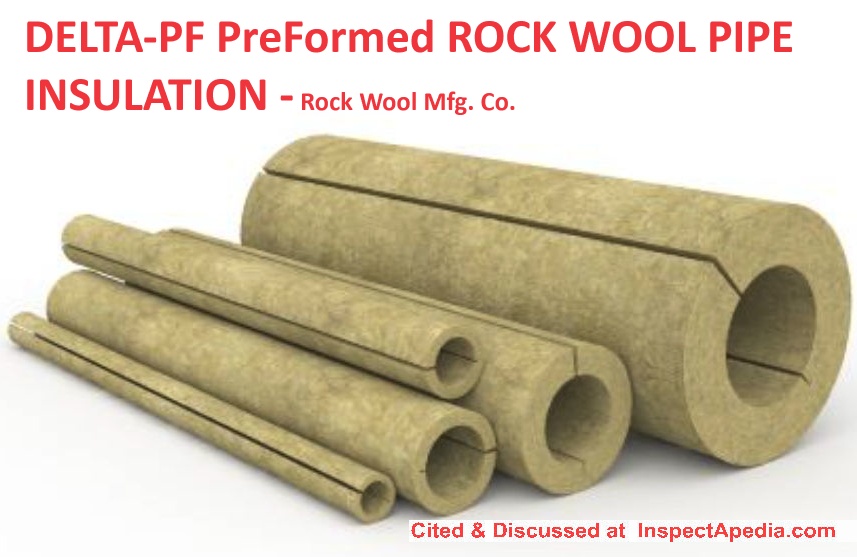
Other businesses with similar names such as Delta Thermal Services, Inc. (f. 1994) a specialist in pipe and ceramic spray insulation continue in operation.
Contact: Delta Thermal Insulation, 55121 211th Lane, Mankato, MN 56001 USA, Tel: (507) 388-0757 Web: https://www.delta-thermal.com/In July 2024 we tried to access deltainsulation.com but only found "not authorized " error messages.
- Gold Bond Rock Wool building Insulation (photo above) is not likely to contain asbestos but other products from that company did, including some including the Rockwool name such as Gold Bond Rockwool No. 340 insulating cement.
Photo above from a 1970's home in Haddonfield New Jersey. Some Gold Bond products sold between 1940 and the early 1980s contained asbestos.
Gold Bond was a subsidiary of Nataion Gypsum. Both Gold Bond and National Gypsum filed for bankruptcy in 1990, establishing an asbestos settlement trust fund of $370 million to handle asbestos claims.
See details about Gold Bond asbestos products and National Gypsum asbestos-containing products
at ASBESTOS PRODUCING COMPANIES & TRUSTS - "Rock Wool Manufacturing Company Asbestos Trust Agreement", retrieved 2015/12/06, original source: http://www.resasb.org/Pdf%20Docs/trustagr.pdf
Excerpt:
Rock Wool filed a voluntary petition for relief under Title 11 of Chapter 11 of the United States Code (the "Bankruptcy Code") on November 18, 1996
- TANSIL v. RAYMARK INDUSTRIES, INC. et al Defendant: KEENE CORPORATION, ROCK WOOL MANUFACTURING CO., RAYMARK INDUSTRIES, INC. Plaintiff: LESLIE SEATON TANSIL
- Bakhshi, Shiv K., Steven H. Williams, James W. Scott, Randall M. Haines, and Ralph D. McGrath. "Method for manufacturing a mineral fiber product." U.S. Patent 5,490,961, issued February 13, 1996.
Bakhshi, Shiv K., Steven H. Williams, James W. Scott, Randall M. Haines, and Ralph D. McGrath. "Multicomponent filaments comprising glass fibers and synthetic fibers joining with melted synthetic fiber particles; uniform distribution, flexibility, impact strength." U.S. Patent 5,736,475, issued April 7, 1998. - Bakhshi, Shiv K., Steven H. Williams, James W. Scott, Randall M. Haines, and Ralph D. McGrath. "Method for manufacturing a mineral fiber product." U.S. Patent 5,490,961, issued February 13, 1996.
- Bakhshi, Shiv K., Steven H. Williams, James W. Scott, Randall M. Haines, and Ralph D. McGrath. "Multicomponent filaments comprising glass fibers and synthetic fibers joining with melted synthetic fiber particles; uniform distribution, flexibility, impact strength." U.S. Patent 5,736,475, issued April 7, 1998.
- Bechler, Andre. "Bearing adjusting device." U.S. Patent 2,424,013, issued July 15, 1947.
- Eugen, Maurer. "Top rolls for drawing systems of ring spinning frames." U.S. Patent 2,873,484, issued February 17, 1959.
- Eugen, Maurer. "Drawing top rolls for ring spinning frames." U.S. Patent 2,927,349, issued March 8, 1960.
- Mossbeck, Niels S. "Reinforced pocketed spring assembly." U.S. Patent 6,295,673, issued October 2, 2001.
- Udayakumar, T. "Insulation Materials for Solar Heating Systems and Their Application." In Solar Water Heating Systems, pp. 129-132. Springer Netherlands, 1986.
- Patel, Mayur M., and Timothy A. Walsh. "Blower for lifting insulation pack." U.S. Patent 6,244,075, issued June 12, 2001.
- Rice, Richard E. "Heat-storage breather system." U.S. Patent 3,320,724, issued May 23, 1967.
Labate, Samuel. "Porous Materials for Noise Control." Noise Control 2, no. 1 (1956): 15-72. - Rutledge, Richard A. "Acoustical panel." U.S. Patent 3,948,347, issued April 6, 1976.
- Wegener, Ing Walther, and Dilp-Ing Willi Zahn. "Vergleich der Gesamt-und der Querstreuung verschiedener Spinnverfahren." In Vergleich des normalen mit verschiedenen abgekürzten Baumwollspinnverfahren in Bezug auf Gleichmäßigkeit und Sortierungsstreuung der Garne, pp. 20-42. VS Verlag für Sozialwissenschaften, 1956.
Interestingly, a current incarnation of Johns Manville produces mineral wool insulating batts (shown above), giving us yet another version of this long-used product. The company notes that this product has a melting point of 2000°F.
- Johns Manville, a Berkshire Hathaway Company, retrieved 2016/11/15, Website: https://www.jm.com/en/home-insulation/products/mineral-wool/
Excerpt: Johns Manville mineral wool insulation batts delay the spread of fire between interior rooms and provide superior fire resistance in exterior walls - Also see more research on mineral wool, slag wool, stone wool, rock wool, or rockwool at References or Citations
...
Reader Comments, Questions & Answers About The Article Above
Below you will find questions and answers previously posted on this page at its page bottom reader comment box.
Reader Q&A - also see RECOMMENDED ARTICLES & FAQs
Question: asbestos in Johns-Manville Super-Felt Insulating Batts?
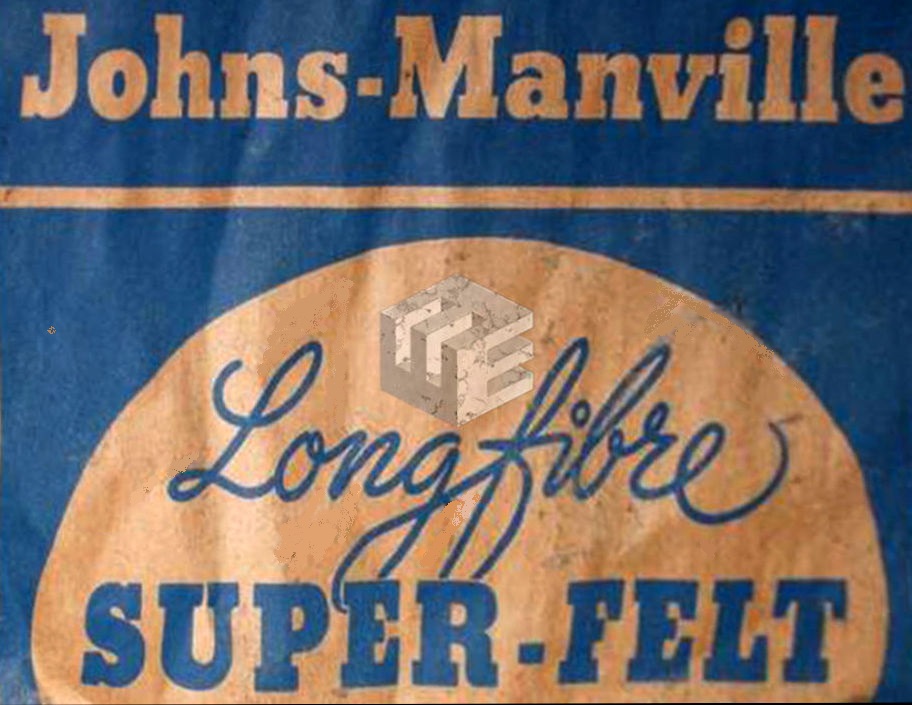 Does John-Mainville super felt Batt insulation contain asbestos - 2021/03/20 Lynne McGoldrick
Does John-Mainville super felt Batt insulation contain asbestos - 2021/03/20 Lynne McGoldrick
Moderator reply:
@Lynne McGoldrick,
Bottom line: As we explain in the article above, mineral wool or "rock wool" products are not an asbestos material.
Details & speculation:
However the question is muddied by research showing that some companies combined mineral wool with asbestos, and by some asbestosis litigation websites who list every product made by Johns Manville among their suspect products.
Possibly for that reason, some sources I've found list and include photos of the covering or wrapping Johns Manville Super Felt "long fibre" insulating batts, tan kraft paper faced with blue inked imprint, included on pages listing Johns Manville products that in fact contained asbestos.
The batts also appear covered with tan kraft paper and imprinted with the following text:
Johns-Manville SUPER FELT An Improved Rock Wool Home Insulation. Year 'Round comfort, fireproof, permanent, cuts fuel bills - John Manville JM Products.
And as you'll read above on this page there were some products that combined asbestos with other insulating fibres. So perhaps that's what Manville was referring-to with this "Improved Rock Wool" - see details in the patent citations I include above.
I'm not sure that that's borne out by independent tests of this specific insulation product as it looks as if it was a mineral wool or rock wool product for which I've not found a lab test result.
The jury wil remain out unless you are of a mind to have a sample of your Super Felt batt insulation tested for asbestos. If you do, please keep me posted as that result will be valuable for others as well.
At ASBESTOS PRODUCING COMPANIES & TRUSTS
under Johns-Manville ASBESTOS PRODUCTS you'll find that company and a list of its products that are known to contain asbestos.
...
Continue reading at MINERAL WOOL IDENTIFICATION, APPEARANCE VARIATIONS or select a topic from the closely-related articles below, or see the complete ARTICLE INDEX.
Or see these
Recommended Articles
- ASBESTOS INSULATION
- ASBESTOS-FREE INSULATION MATERIALS
- INSULATION IDENTIFICATION GUIDE - home
- MINERAL WOOL - ROCK WOOL INSULATION
- CAREY ROCK WOOL CATALOG 1950 [PDF]
- MINERAL WOOL IDENTIFICATION, APPEARANCE
- MINERAL WOOL IDENTIFICATION by MICROSCOPE
- MINERAL / SLAG WOOL AIRBORNE PARTICLES
- MINERAL WOOL / STONE WOOL ASBESTOS CONTENT
- MINERAL WOOL / ROCK WOOL DEFINITIONS
- MINERAL WOOL / ROCKWOOL COMPOSITION
- MINERAL or SLAG WOOL HEALTH EFFECTS
- MINERAL / ROCK WOOL INSTALLATION, SETTLING
- MINERAL WOOL / STONE WOOL R-VALUES
- SPINTEX MINERAL WOOL PROPERTIES - MANSVILLE
Suggested citation for this web page
ASBESTOS IN MINERAL WOOL / STONE WOOL at InspectApedia.com - online encyclopedia of building & environmental inspection, testing, diagnosis, repair, & problem prevention advice.
Or see this
INDEX to RELATED ARTICLES: ARTICLE INDEX to BUILDING INSULATION
Or use the SEARCH BOX found below to Ask a Question or Search InspectApedia
Ask a Question or Search InspectApedia
Try the search box just below, or if you prefer, post a question or comment in the Comments box below and we will respond promptly.
Search the InspectApedia website
Note: appearance of your Comment below may be delayed: if your comment contains an image, photograph, web link, or text that looks to the software as if it might be a web link, your posting will appear after it has been approved by a moderator. Apologies for the delay.
Only one image can be added per comment but you can post as many comments, and therefore images, as you like.
You will not receive a notification when a response to your question has been posted.
Please bookmark this page to make it easy for you to check back for our response.
IF above you see "Comment Form is loading comments..." then COMMENT BOX - countable.ca / bawkbox.com IS NOT WORKING.
In any case you are welcome to send an email directly to us at InspectApedia.com at editor@inspectApedia.com
We'll reply to you directly. Please help us help you by noting, in your email, the URL of the InspectApedia page where you wanted to comment.
Citations & References
In addition to any citations in the article above, a full list is available on request.
- Cummings, J. M. "Possibilities for the Manufacture of Mineral Wool in British Columbia" [PDF], British Columbia Department of Mines, (1937)- includes tables comparing properties of various insulation and other materials to mineral wool and balsam wool, retrieved 12/6/2014, original source: http://142.32.76.167/Mining/Geoscience/ PublicationsCatalogue/MiscellaneousPublications/ Documents/PossibilitiesManufactureMineralWool1937.pdf
- [1] Seattle Energy Code, Seattle Energy Code History, web search 12/6/2011, original source: http://www.seattle.gov/dpd/Codes/Energy_Code/Overview/history.asp
- Adams, P. "Effects of increasing the salinity of the nutrient solution with major nutrients or sodium chloride on the yield, quality and composition of tomatoes grown in rockwool." Journal of Horticultural Science 66, no. 2 (1991): 201-207.
- Awang, Y. B., J. G. Atherton, and A. J. Taylor. "Salinity effects on strawberry plants grown in rockwool. I. Growth and leaf water relations." Journal of Horticultural Science 68, no. 5 (1993): 783-790.
- Awang, Yahya B., and J. G. Atherton. "Growth and fruiting responses of strawberry plants grown on rockwool to shading and salinity." Scientia Horticulturae 62, no. 1 (1995): 25-31.
- Eparvier, Agnès, Philippe Lemanceau, and Claude Alabouvette. "Population dynamics of non-pathogenic Fusarium and fluorescent Pseudomonas strains in rockwool, a substratum for soilless culture." FEMS Microbiology Letters 86, no. 2 (1991): 177-184.
Abstract
In soilless cropping systems, soil-borne plant pathogens, especially Fusarium oxysporum, are responsible for severe damage in vegetable and flower cultures. Non-pathogenic Fusarium and fluorescent Pseudomonas are able to control fusarium diseases, thereby increasing the yield.
The association of the non-pathogenic Fusarium strain Fo47 and of the fluorescent Pseudomonas strain C7R12 gave a better control of fusarium diseases compared to single inoculations of each antagonistic microorganism. So far, no data have been available on the survival of these two microorganisms in soilless growing substrate.
The results of this study indicate that both microorganisms survive well in rockwool when inoculated alone or together as well as in the absence or the presence of plants. Under the present experimental conditions, a single application of the antagonists appears to be enough to get a significant control of fusarium wilts. - Fonteno, William C., and Paul V. Nelson. "Physical properties of and plant responses to rockwool-amended media." Journal of the American Society for Horticultural Science 115, no. 3 (1990): 375-381.
Abstract:
Loose rockwool had a total porosity similar to peatmoss (92%, by volume) but with water retention capabilities similar to sand. Root media formulations containing loose rockwool were tested with seven plant species for plant response and nutrient uptake. The volume percent formulation, 20 rockwool : 10 peatmoss : 20 vermiculite : 45 pine bark : 5 perlite, was superior to formulations containing 10% or 30% rockwool.
Plant response in this rockwool medium in bedding plant flats was superior to that in two high-performing commercial media for impatiens (Impatiens sultanii Hook), marigold (Tagetes patula L.), and petunia (Petunia hybrida Vilm) and equal to one commercial medium for tomato (Lycopersicon esculentum Mill.).
However, response of chrysanthemum (Chrysanthemum × morifolium Ramat.), geranium (Pelargonium × hortorum Bailey), and poinsettia (Euphorbia pulcherrima Willd. ex Kl.) in 1.58-liter pots was inferior to both commercial media in one-half of the trials.
Differential plant responses in the root media treatments did not relate directly to differences found to occur in plant nutrient composition. The high initial pH level of rockwool necessitated reduced application of limestone and increased application of calcium sulfate to offset Ca deficiency. - Fuchs, J-G., Y. Moënne-Loccoz, and G. Défago. "Nonpathogenic Fusarium oxysporum strain Fo47 induces resistance to Fusarium wilt in tomato." Plant Disease 81, no. 5 (1997): 492-496.
- Galera, Melvin Maaliw, Eulsaeng Cho, Enkhdul Tuuguu, Shin-Jung Park, Changhee Lee, and Wook-Jin Chung. "Effects of pollutant concentration ratio on the simultaneous removal of NH 3, H 2 S and toluene gases using rock wool-compost biofilter." Journal of Hazardous Materials 152, no. 2 (2008): 624-631.
Abstract:
The need to find economically and environmentally more viable methods for the management of industrial wastes has opened the way to the research and development of processes which were still in the laboratory only a few years ago. The examples given concern two very common and acutely-felt problems: the inertization and recycling of hydrometallurgical red muds (RM) and of mine tailings. In the case of red mud, one potential process involves the extraction of metals (mainly Zn, but also Cd, Sn, Ph, Fe), and another involves mixing the RM with granite chippings and cullet to produce glass-ceramics materials via melting and crystallization. The paper also discusses a new flowsheet in which mine tailings are utilized to produce either glass-wool or very strong glass-ceramic products, with good resistance to chemical attack. - Kim, K-A., W. K. Lee, J. K. Kim, M-S. Seo, Y. Lim, K-H. Lee, G. Chae, S-H. Lee, and Y. Chung. "Mechanism of refractory ceramic fiber-and rock wool-induced cytotoxicity in alveolar macrophages." International archives of occupational and environmental health 74, no. 1 (2000): 9-15.
- Leeman, M., J. A. Van Pelt, F. M. Den Ouden, M. Heinsbroek, P. A. H. M. Bakker, and B. Schippers. "Induction of systemic resistance byPseudomonas fluorescens in radish cultivars differing in susceptibility to fusarium wilt, using a novel bioassay." European Journal of Plant Pathology 101, no. 6 (1995): 655-664.
- Marabini, Anna Maria, Paolo Plescia, Dante Maccari, Francesco Burragato, and Mario Pelino. "New materials from industrial and mining wastes: glass-ceramics and glass-and rock-wool fibre." International journal of mineral processing 53, no. 1 (1998): 121-134.
Abstract:
The need to find economically and environmentally more viable methods for the management of industrial wastes has opened the way to the research and development of processes which were still in the laboratory only a few years ago. The examples given concern two very common and acutely-felt problems: the inertization and recycling of hydrometallurgical red muds (RM) and of mine tailings.
In the case of red mud, one potential process involves the extraction of metals (mainly Zn, but also Cd, Sn, Ph, Fe), and another involves mixing the RM with granite chippings and cullet to produce glass-ceramics materials via melting and crystallization.
The paper also discusses a new flowsheet in which mine tailings are utilized to produce either glass-wool or very strong glass-ceramic products, with good resistance to chemical attack. - Marsh, G., R. Stone, A. Youk, T. Smith, M. Quinn, V. Henderson, L. Schall, L. Wayne, and K. Lee. "Mortality among United States rock wool and slag wool workers: 1989 update." JOURNAL OF OCCUPATIONAL HEALTH AND SAFETY AUSTRALIA AND NEW ZEALAND 12 (1996): 297-312.
- McCullagh, M., R. Utkhede, J. G. Menzies, Z. K. Punja, and T. C. Paulitz. "Evaluation of plant growth-promoting rhizobacteria for biological control of Pythium root rot of cucumbers grown in rockwool and effects on yield." European Journal of Plant Pathology 102, no. 8 (1996): 747-755.
- Mihuta-Grimm, L., W. A. Erb, and R. C. Rowe. "Fusarium crown and root rot of tomato in greenhouse rock wool systems: sources of inoculum and disease management with benomyl." Plant disease 74, no. 12 (1990): 996-1002.
- Postma, Joeke, Margarit JEIM Willemsen-de Klein, and Jan Dirk van Elsas. "Effect of the indigenous microflora on the development of root and crown rot caused by Pythium aphanidermatum in cucumber grown on rockwool." Phytopathology 90, no. 2 (2000): 125-133.
- Olympios, C. M. "Soilless media under protected cultivation rockwool, peat, perlite and other substrates." In Symposium on Soil and Soilless Media under Protected Cultivation in Mild Winter Climates 323, pp. 215-234. 1992.
- Rockwool International (PDF document on rock wool sustainability), Rockwool International A/S · Hovedgaden 584 · 2640 Hedehusene · Telephone (+45) 46 56 03 00 · Telefax (+45) 46 56 33 11 , website: http://www.rockwool.com/, is a current manufacturer of mineral wool insulation products used for fire insulation, sound insulation, and building insulation.
- Savvas, D., and F. Lenz. "Effects of NaCl or nutrient-induced salinity on growth, yield, and composition of eggplants grown in rockwool." Scientia Horticulturae 84, no. 1 (2000): 37-47.
- Smith, Denis. Rockwool in horticulture. Grower Books, 1987.
- 3/07: thanks to Gary Randolph, Ounce of Prevention Home Inspection, LLC Buffalo, NY, for attentive reading and editing suggestions. Mr. Randolph can be reached in Buffalo, NY, at (716) 636-3865 or email: gary@ouncehome.com
- ThermaFiber, Thermafiber, Inc., 3711 Mill Street, Wabash, Indiana 46992, Toll Free: 888-834-2371 (U.S. & Canada) ; Phone: 260-563-2111, is a current manufacturer of mineral wool insulation products. http://www.thermafiber.com/ Web search 07/28/2010, quoting:
Thermafiber manufactures and customizes mineral wool insulation for commercial buildings, industrial applications and residential construction. We specialize in high-rise construction - that's why we developed Thermafiber Insolutions™, a systematic approach to help you precisely plan and install insulation on time and on budget. - In addition to citations & references found in this article, see the research citations given at the end of the related articles found at our suggested
CONTINUE READING or RECOMMENDED ARTICLES.
- Carson, Dunlop & Associates Ltd., 120 Carlton Street Suite 407, Toronto ON M5A 4K2. Tel: (416) 964-9415 1-800-268-7070 Email: info@carsondunlop.com. Alan Carson is a past president of ASHI, the American Society of Home Inspectors.
Thanks to Alan Carson and Bob Dunlop, for permission for InspectAPedia to use text excerpts from The HOME REFERENCE BOOK - the Encyclopedia of Homes and to use illustrations from The ILLUSTRATED HOME .
Carson Dunlop Associates provides extensive home inspection education and report writing material. In gratitude we provide links to tsome Carson Dunlop Associates products and services.



